 |
 |
The Smash of Civilizations
by Chalmers Johnson
|
READ
U.S. And Polish Troops Destroyed Artifacts At Ruins Of Babylon

|
|
 |
[Extracted from Chalmers Johnson's Nemesis: The Crisis of the American Republic, forthcoming from Metropolitan Books in late 2006, the final volume in the Blowback Trilogy. The first two volumes are Blowback: The Costs and Consequences of American Empire (2000) and The Sorrows of Empire: Militarism, Secrecy, and the End of the Republic (2004)]
In
the months before he ordered the invasion of Iraq, George Bush and his senior officials spoke of preserving Iraq's "patrimony" for the Iraqi people. At a time when talking about Iraqi oil was taboo, what he meant by patrimony was exactly that -- Iraqi oil. In their "joint statement on Iraq's future" of April 8, 2003, George Bush and Tony Blair declared, "We reaffirm our commitment to protect Iraq's natural resources, as the patrimony of the people of Iraq, which should be used only for their benefit." In this they were true to their word. Among the few places American soldiers actually did guard during and in the wake of their invasion were oil fields and the Oil Ministry in Baghdad. But the real Iraqi patrimony, that invaluable human inheritance of thousands of years, was another matter. At a time when American pundits were warning of a future "clash of civilizations," our occupation forces were letting perhaps the greatest of all human patrimonies be looted and smashed.
| |
|
|
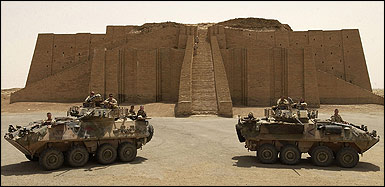
| |
Coalition soldiers in front of the Great Ziggurat of Ur, a four-thousand-year-old temple in southern Iraq which is one of the archaeological treasures of the world. The military has placed the monument off limits in order to disguise the vandalism by U.S. soldiers, including the looting of clay bricks and spray-painting "Semper Fi" onto its walls
|
There have been many dispiriting sights on TV since George Bush launched his ill-starred war on Iraq -- the pictures from Abu Ghraib, Falluja laid waste, American soldiers kicking down the doors of private homes and pointing assault rifles at women and children. But few have reverberated historically like the looting of Baghdad's museum -- or been forgotten more quickly in this country.
In archaeological circles, Iraq is known as "the cradle of civilization," with a record of culture going back more than 7,000 years. William R. Polk, the founder of the Center for Middle Eastern Studies at the University of Chicago, says, "It was there, in what the Greeks called Mesopotamia, that life as we know it today began: there people first began to speculate on philosophy and religion, developed concepts of international trade, made ideas of beauty into tangible forms, and, above all developed the skill of writing." No other places in the Bible except for Israel have more history and prophecy associated with them than Babylonia, Shinar (Sumer), and Mesopotamia -- different names for the territory that the British around the time of World War I began to call "Iraq," using the old Arab term for the lands of the former Turkish enclave of Mesopotamia (in Greek: "between the [Tigris and Eurphrates] rivers"). Most of the early books of Genesis are set in Iraq (see, for instance, Genesis 10:10, 11:31; also Daniel 1-4; II Kings 24).
The best-known of the civilizations that make up Iraq's cultural heritage are the Sumerians, Akkadians, Babylonians, Assyrians, Chaldeans, Persians, Greeks, Romans, Parthians, Sassanids, and Muslims. On April 10, 2003, in a television address, President Bush acknowledged that the Iraqi people are "the heirs of a great civilization that contributes to all humanity." Only two days later, under the complacent eyes of the U.S. Army, the Iraqis would begin to lose that heritage in a swirl of looting and burning.
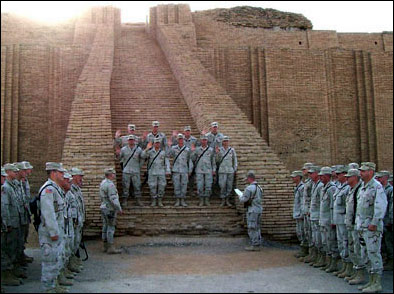
| |
Although the Ziggurat of Ur is off-limits, a reenlistment ceremony for West Virginia National Guardsmen was held New Year's Day 2005 (PHOTO: ARMY/Maj. Gary Coffey)
|
In September 2004, in one of the few self-critical reports to come out of Donald Rumsfeld's Department of Defense, the Defense Science Board Task Force on Strategic Communication wrote: "The larger goals of U.S. strategy depend on separating the vast majority of non-violent Muslims from the radical-militant Islamist-Jihadists. But American efforts have not only failed in this respect: they may also have achieved the opposite of what they intended." Nowhere was this failure more apparent than in the indifference -- even the glee -- shown by Rumsfeld and his generals toward the looting on April 11 and 12, 2003, of the National Museum in Baghdad and the burning on April 14, 2003, of the National Library and Archives as well as the Library of Korans at the Ministry of Religious Endowments. These events were, according to Paul Zimansky, a Boston University archaeologist, "the greatest cultural disaster of the last 500 years." Eleanor Robson of All Souls College, Oxford, said, "You'd have to go back centuries, to the Mongol invasion of Baghdad in 1258, to find looting on this scale." Yet Secretary Rumsfeld compared the looting to the aftermath of a soccer game and shrugged it off with the comment that "Freedom's untidy. . . . Free people are free to make mistakes and commit crimes."
The Baghdad archaeological museum has long been regarded as perhaps the richest of all such institutions in the Middle East. It is difficult to say with precision what was lost there in those catastrophic April days in 2003 because up-to-date inventories of its holdings, many never even described in archaeological journals, were also destroyed by the looters or were incomplete thanks to conditions in Baghdad after the Gulf War of 1991. One of the best records, however partial, of its holdings is the catalog of items the museum lent in 1988 to an exhibition held in Japan's ancient capital of Nara entitled Silk Road Civilizations. But, as one museum official said to John Burns of the New York Times after the looting, "All gone, all gone. All gone in two days."
A single, beautifully illustrated, indispensable book edited by Milbry Park and Angela M.H. Schuster, The Looting of the Iraq Museum, Baghdad: The Lost Legacy of Ancient Mesopotamia (New York: Harry N. Abrams, 2005), represents the heartbreaking attempt of over a dozen archaeological specialists on ancient Iraq to specify what was in the museum before the catastrophe, where those objects had been excavated, and the condition of those few thousand items that have been recovered. The editors and authors have dedicated a portion of the royalties from this book to the Iraqi State Board of Antiquities and Heritage.
At a conference on art crimes held in London a year after the disaster, the British Museum's John Curtis reported that at least half of the forty most important stolen objects had not been retrieved and that of some 15,000 items looted from the museum's showcases and storerooms about 8,000 had yet to be traced. Its entire collection of 5,800 cylinder seals and clay tablets, many containing cuneiform writing and other inscriptions some of which go back to the earliest discoveries of writing itself, was stolen. Since then, as a result of an amnesty for looters, about 4,000 of the artifacts have been recovered in Iraq, and over a thousand have been confiscated in the United States. Curtis noted that random checks of Western soldiers leaving Iraq had led to the discovery of several in illegal possession of ancient objects. Customs agents in the U.S. then found more. Officials in Jordan have impounded about 2,000 pieces smuggled in from Iraq; in France, 500 pieces; in Italy, 300; in Syria, 300; and in Switzerland, 250. Lesser numbers have been seized in Kuwait, Saudi Arabia, Iran, and Turkey. None of these objects has as yet been sent back to Baghdad.
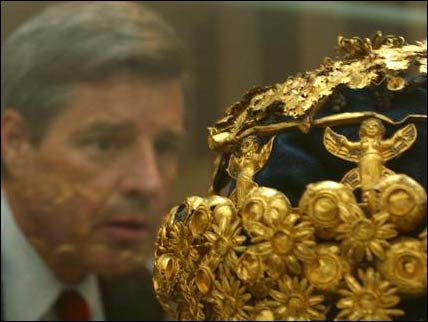
| |
CPA chief Paul Bremer views the golden crown from Nimrud in the National Museum on July 3, 2003 (PHOTO: Noreen Feeney/Iraq Museum International)
|
The 616 pieces that form the famous collection of "Nimrud gold," excavated by the Iraqis in the late 1980s from the tombs of the Assyrian queens at Nimrud, a few miles southeast of Mosul, were saved, but only because the museum had secretly moved them to the subterranean vaults of the Central Bank of Iraq at the time of the first Gulf War. By the time the Americans got around to protecting the bank in 2003, its building was a burnt-out shell filled with twisted metal beams from the collapse of the roof and all nine floors under it. Nonetheless, the underground compartments and their contents survived undamaged. On July 3, 2003, a small portion of the Nimrud holdings was put on display for a few hours, allowing a handful of Iraqi officials to see them for the first time since 1990.
The torching of books and manuscripts in the Library of Korans and the National Library was in itself a historical disaster of the first order. Most of the Ottoman imperial documents and the old royal archives concerning the creation of Iraq were reduced to ashes. According to Humberto Marquez, the Venezuelan writer and author of Historia Universal de La Destruccion de Los Libros (2004), about a million books and ten million documents were destroyed by the fires of April 14, 2003. Robert Fisk, the veteran Middle East correspondent of the Independent of London, was in Baghdad the day of the fires. He rushed to the offices of the U.S. Marines' Civil Affairs Bureau and gave the officer on duty precise map locations for the two archives and their names in Arabic and English, and pointed out that the smoke could be seen from three miles away. The officer shouted to a colleague, "This guy says some biblical library is on fire," but the Americans did nothing to try to put out the flames.
| |
The Burger King of Ur

|
|
 |
Given
the black market value of ancient art objects, U.S. military leaders had been warned that the looting of all thirteen national museums throughout the country would be a particularly grave danger in the days after they captured Baghdad and took control of Iraq. In the chaos that followed the Gulf War of 1991, vandals had stolen about 4,000 objects from nine different regional museums. In monetary terms, the illegal trade in antiquities is the third most lucrative form of international trade globally, exceeded only by drug smuggling and arms sales. Given the richness of Iraq's past, there are also over 10,000 significant archaeological sites scattered across the country, only some 1,500 of which have been studied. Following the Gulf War, a number of them were illegally excavated and their artifacts sold to unscrupulous international collectors in Western countries and Japan. All this was known to American commanders.
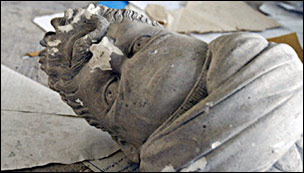
| |
Decapitated and defaced statue at the Iraq Museum
|
In January 2003, on the eve of the invasion of Iraq, an American delegation of scholars, museum directors, art collectors, and antiquities dealers met with officials at the Pentagon to discuss the forthcoming invasion. They specifically warned that Baghdad's National Museum was the single most important site in the country. McGuire Gibson of the University of Chicago's Oriental Institute said, "I thought I was given assurances that sites and museums would be protected." Gibson went back to the Pentagon twice to discuss the dangers, and he and his colleagues sent several e-mail reminders to military officers in the weeks before the war began. However, a more ominous indicator of things to come was reported in the April 14, 2003, London Guardian: Rich American collectors with connections to the White House were busy "persuading the Pentagon to relax legislation that protects Iraq's heritage by prevention of sales abroad." On January 24, 2003, some sixty New York-based collectors and dealers organized themselves into a new group called the American Council for Cultural Policy and met with Bush administration and Pentagon officials to argue that a post-Saddam Iraq should have relaxed antiquities laws. Opening up private trade in Iraqi artifacts, they suggested, would offer such items better security than they could receive in Iraq.
The main international legal safeguard for historically and humanistically important institutions and sites is the Hague Convention for the Protection of Cultural Property in the Event of Armed Conflict, signed on May 14, 1954. The U.S. is not a party to that convention, primarily because, during the Cold War, it feared that the treaty might restrict its freedom to engage in nuclear war; but during the 1991 Gulf War the elder Bush's administration accepted the convention's rules and abided by a "no-fire target list" of places where valuable cultural items were known to exist. UNESCO and other guardians of cultural artifacts expected the younger Bush's administration to follow the same procedures in the 2003 war.
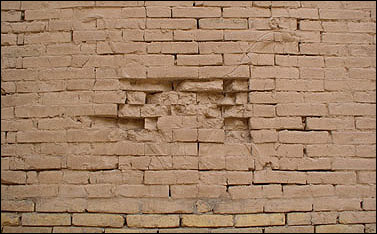
| |
Detail of damage to the Ishtar Gate
|
Moreover, on March 26, 2003, the Pentagon's Office of Reconstruction and Humanitarian Assistance (ORHA), headed by Lt. Gen. (ret.) Jay Garner -- the civil authority the U.S. had set up for the moment hostilities ceased -- sent to all senior U.S. commanders a list of sixteen institutions that "merit securing as soon as possible to prevent further damage, destruction, and/or pilferage of records and assets." The five-page memo dispatched two weeks before the fall of Baghdad also said, "Coalition forces must secure these facilities in order to prevent looting and the resulting irreparable loss of cultural treasures" and that "looters should be arrested/detained." First on Gen. Garner's list of places to protect was the Iraqi Central Bank, which is now a ruin; second was the Museum of Antiquities. Sixteenth was the Oil Ministry, the only place that U.S. forces occupying Baghdad actually defended. Martin Sullivan, chair of the President's Advisory Committee on Cultural Property for the previous eight years, and Gary Vikan, director of the Walters Art Museum in Baltimore and a member of the committee, both resigned to protest the failure of CENTCOM to obey orders. Sullivan said it was "inexcusable" that the museum should not have had the same priority as the Oil Ministry.
As we now know, the American forces made no effort to prevent the looting of the great cultural institutions of Iraq, its soldiers simply watching vandals enter and torch the buildings. Said Arjomand, an editor of the journal Studies on Persianate Societies and a professor of sociology at the State University of New York at Stony Brook, wrote, "Our troops, who have been proudly guarding the Oil Ministry, where no window is broken, deliberately condoned these horrendous events." American commanders claim that, to the contrary, they were too busy fighting and had too few troops to protect the museum and libraries. However, this seems to be an unlikely explanation. During the battle for Baghdad, the U.S. military was perfectly willing to dispatch some 2,000 troops to secure northern Iraq's oilfields, and their record on antiquities did not improve when the fighting subsided. At the 6,000-year-old Sumerian city of Ur with its massive ziggurat, or stepped temple-tower (built in the period 2112 -- 2095 B.C. and restored by Nebuchadnezzar II in the sixth century B.C.), the Marines spray-painted their motto, "Semper Fi" (semper fidelis, always faithful) onto its walls. The military then made the monument "off limits" to everyone in order to disguise the desecration that had occurred there, including the looting by U.S. soldiers of clay bricks used in the construction of the ancient buildings.
Until April 2003, the area around Ur, in the environs of Nasiriya, was remote and sacrosanct. However, the U.S. military chose the land immediately adjacent to the ziggurat to build its huge Tallil Air Base with two runways measuring 12,000 and 9,700 feet respectively and four satellite camps. In the process, military engineers moved more than 9,500 truckloads of dirt in order to build 350,000 square feet of hangars and other facilities for aircraft and Predator unmanned drones. They completely ruined the area, the literal heartland of human civilization, for any further archaeological research or future tourism. On October 24, 2003, according to the Global Security Organization, the Army and Air Force built its own modern ziggurat. It "opened its second Burger King at Tallil. The new facility, co-located with [a] . . . Pizza Hut, provides another Burger King restaurant so that more service men and women serving in Iraq can, if only for a moment, forget about the task at hand in the desert and get a whiff of that familiar scent that takes them back home."
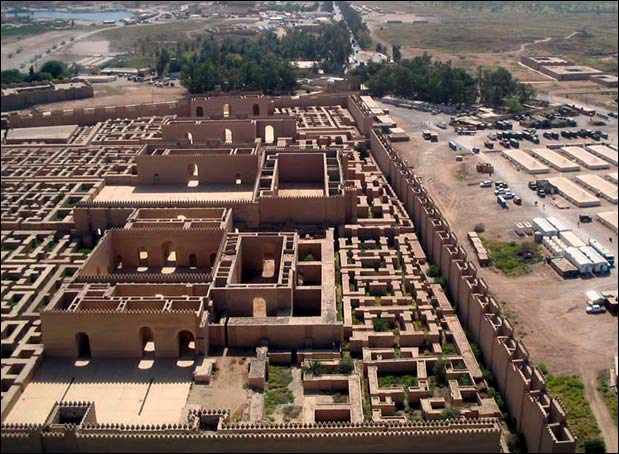
| |
An aerial view of Babylon showing the reconstructed Palace of Nebuchadnezzar, with adjacent helipad (at the top, between the palace and the lake) and trailers for military housing (PHOTO: Martin Bailey January 25, 2005)
|
The great British archaeologist, Sir Max Mallowan (husband of Agatha Christie), who pioneered the excavations at Ur, Nineveh, and Nimrud, quotes some classical advice that the Americans might have been wise to heed: "There was danger in disturbing ancient monuments. . . . It was both wise and historically important to reverence the legacies of ancient times. Ur was a city infested with ghosts of the past and it was prudent to appease them."
The American record elsewhere in Iraq is no better. At Babylon, American and Polish forces built a military depot, despite objections from archaeologists. John Curtis, the British Museum's authority on Iraq's many archaeological sites, reported on a visit in December 2004 that he saw "cracks and gaps where somebody had tried to gouge out the decorated bricks forming the famous dragons of the Ishtar Gate" and a "2,600-year-old brick pavement crushed by military vehicles." Other observers say that the dust stirred up by U.S. helicopters has sandblasted the fragile brick facade of the palace of Nebuchadnezzar II, king of Babylon from 605 to 562 B.C. The archaeologist Zainab Bahrani reports, "Between May and August 2004, the wall of the Temple of Nabu and the roof of the Temple of Ninmah, both of the sixth century B.C, collapsed as a result of the movement of helicopters. Nearby, heavy machines and vehicles stand parked on the remains of a Greek theater from the era of Alexander of Macedon [Alexander the Great]."
And none of this even begins to deal with the massive, ongoing looting of historical sites across Iraq by freelance grave and antiquities robbers, preparing to stock the living rooms of western collectors. The unceasing chaos and lack of security brought to Iraq in the wake of our invasion have meant that a future peaceful Iraq may hardly have a patrimony to display. It is no small accomplishment of the Bush administration to have plunged the cradle of the human past into the same sort of chaos and lack of security as the Iraqi present. If amnesia is bliss, then the fate of Iraq's antiquities represents a kind of modern paradise.
President Bush's supporters have talked endlessly about his global war on terrorism as a "clash of civilizations." But the civilization we are in the process of destroying in Iraq is part of our own heritage. It is also part of the world's patrimony. Before our invasion of Afghanistan, we condemned the Taliban for their dynamiting of the monumental third century A.D. Buddhist statues at Bamiyan in March, 2001. Those were two gigantic statues of remarkable historical value and the barbarism involved in their destruction blazed in headlines and horrified commentaries in our country. Today, our own government is guilty of far greater crimes when it comes to the destruction of a whole universe of antiquity, and few here, when they consider Iraqi attitudes toward the American occupation, even take that into consideration. But what we do not care to remember, others may recall all too well.
© 2005 Chalmers JohnsonThis article first appeared in Tomdispatch.com and is reprinted by permission
Comments? Send a letter to the editor.Albion Monitor
September 28, 2005 (http://www.albionmonitor.com)All Rights Reserved. Contact rights@monitor.net for permission to use in any format. |
|

